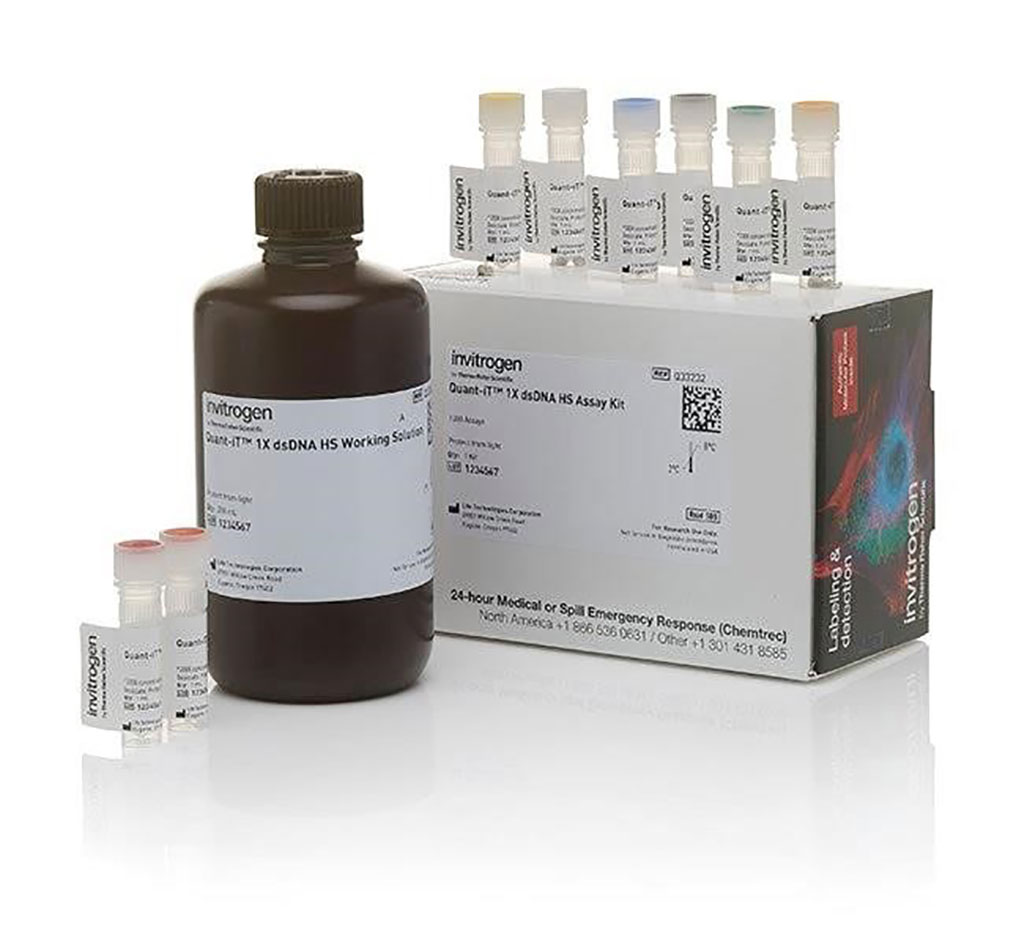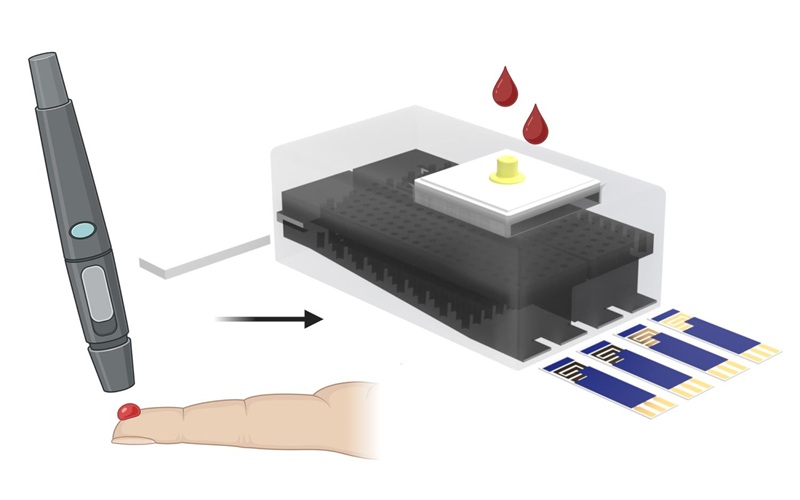Automated Detection of Arm-Level Alterations for Individual Cancer Patients
|
By LabMedica International staff writers Posted on 25 Sep 2021 |

The Quant-iT 1X dsDNA HS (High-Sensitivity) Assay Kit is designed to make DNA quantitation easy and accurate. The assay is highly selective for double-stranded DNA (dsDNA) over RNA (Photo courtesy of Thermo Fisher Scientific)
Copy number alterations (CNAs) can be gains, losses, or loss of heterozygosity (LOH) of a chromosome segment. Based on the length of the altered segment, they are crudely classified as “focal alterations” and “arm-level alterations”.
While genome-wide techniques to detect arm-level alterations are gaining momentum in hospital laboratories, the high precision and novelty of these techniques pose new challenges. There is no consensus on the definition of an arm-level alteration and a lack of tools to compute them for individual patients.
Clinical Scientists at the Geneva University Hospital (Geneva, Switzerland) performed OncoScan FFPE assays (Thermo Fisher Scientific, Waltham, MA, USA) for more than 400 patients as part of the routine laboratory analyses from 2016 to 2018. The median age at the time of analysis was 59 years for females and 60 years for males. Among these 376 samples, 25 were manually selected to validate the method against the expert annotations from the clinical report. Centered on the content of the clinical reports, the selection was made to represent a diverse range of arm-level alterations in terms of chromosomal distribution, CNA type (Gain versus. Loss of copies), tumor ploidy, and the number of arms altered.
Genomic DNA was purified from Formalin-Fixed Paraffin-Embedded (FFPE) tumor tissues using QIAamp DNA FFPE Tissue Kit (QIAGEN (Hilden, Germany) and quantified using the Quant-iT dsDNA HS Assay Kit (Life Technologies, CA, USA). The arrays were stained in GeneChip Fluidics Station (Thermo Fisher Scientific) and scanned using the Gene Chip scanner. The OncoScan assay has a genome-wide resolution of 300Kbp and an even finer 50-100Kbp resolution on ∼ 900 cancer genes.
The team observed a bimodal distribution of the percentage of bases with CNAs within a chromosomal arm, with the second peak starting at 90% of arm length. They tested two approaches for the definition of arm-level alterations: sum of altered segments (SoS) >90% or the longest segment (LS) >90%. The approaches were validated against expert annotation of 25 clinical cases. The SoS method outperformed the LS method with a higher concordance (SoS: 95.2 %, LS: 79.9 %). Some of the discordances were ultimately attributed to human error, highlighting the advantages of automation. The investigators observed that both computational approaches (SoS and LS) showed a high number of arm-level alterations (Gain (27), Loss (14) and LOH (8)), which were missed by the manual annotation, but detected by this approach.
The authors concluded that their computational method is highly accurate and robust for detecting copy number alterations across diverse cancer types in a clinical setting. The method performs as accurately as human experts, but at a fraction of the time. A software tool also increases reliability, as typographic and annotation errors were observed in some manually curated cases. The method and tool they described are now routinely used in the Department of Clinical Pathology at the Geneva University Hospitals and are available to the community. The study was published on August 25, 2021 in The Journal of Molecular Diagnosis.
While genome-wide techniques to detect arm-level alterations are gaining momentum in hospital laboratories, the high precision and novelty of these techniques pose new challenges. There is no consensus on the definition of an arm-level alteration and a lack of tools to compute them for individual patients.
Clinical Scientists at the Geneva University Hospital (Geneva, Switzerland) performed OncoScan FFPE assays (Thermo Fisher Scientific, Waltham, MA, USA) for more than 400 patients as part of the routine laboratory analyses from 2016 to 2018. The median age at the time of analysis was 59 years for females and 60 years for males. Among these 376 samples, 25 were manually selected to validate the method against the expert annotations from the clinical report. Centered on the content of the clinical reports, the selection was made to represent a diverse range of arm-level alterations in terms of chromosomal distribution, CNA type (Gain versus. Loss of copies), tumor ploidy, and the number of arms altered.
Genomic DNA was purified from Formalin-Fixed Paraffin-Embedded (FFPE) tumor tissues using QIAamp DNA FFPE Tissue Kit (QIAGEN (Hilden, Germany) and quantified using the Quant-iT dsDNA HS Assay Kit (Life Technologies, CA, USA). The arrays were stained in GeneChip Fluidics Station (Thermo Fisher Scientific) and scanned using the Gene Chip scanner. The OncoScan assay has a genome-wide resolution of 300Kbp and an even finer 50-100Kbp resolution on ∼ 900 cancer genes.
The team observed a bimodal distribution of the percentage of bases with CNAs within a chromosomal arm, with the second peak starting at 90% of arm length. They tested two approaches for the definition of arm-level alterations: sum of altered segments (SoS) >90% or the longest segment (LS) >90%. The approaches were validated against expert annotation of 25 clinical cases. The SoS method outperformed the LS method with a higher concordance (SoS: 95.2 %, LS: 79.9 %). Some of the discordances were ultimately attributed to human error, highlighting the advantages of automation. The investigators observed that both computational approaches (SoS and LS) showed a high number of arm-level alterations (Gain (27), Loss (14) and LOH (8)), which were missed by the manual annotation, but detected by this approach.
The authors concluded that their computational method is highly accurate and robust for detecting copy number alterations across diverse cancer types in a clinical setting. The method performs as accurately as human experts, but at a fraction of the time. A software tool also increases reliability, as typographic and annotation errors were observed in some manually curated cases. The method and tool they described are now routinely used in the Department of Clinical Pathology at the Geneva University Hospitals and are available to the community. The study was published on August 25, 2021 in The Journal of Molecular Diagnosis.
Related Links:
Geneva University Hospital
Thermo Fisher Scientific
QIAGEN
Life Technologies
Latest Molecular Diagnostics News
- Four-Gene Blood Test Rules Out Bacterial Lung Infection
- New PCR Test Improves Diagnostic Accuracy of Bacterial Vaginosis and Candida Vaginitis
- New Serum Marker-Editing Strategy to Improve Diagnosis of Neurological Diseases
- World’s First Genetic Type 1 Diabetes Risk Test Enables Early Detection
- Blood Test to Help Low-Risk Gastric Cancer Patients Avoid Unnecessary Surgery
- First-Of-Its-Kind Automated System Speeds Myeloma Diagnosis
- Blood Protein Profiles Predict Mortality Risk for Earlier Medical Intervention
- First Of Its Kind Blood Test Detects Gastric Cancer in Asymptomatic Patients
- Portable Molecular Test Detects STIs at POC in 15 Minutes
- Benchtop Analyzer Runs Chemistries, Immunoassays and Hematology in Single Device
- POC Bordetella Test Delivers PCR-Accurate Results in 15 Minutes
- Pinprick Blood Test Could Detect Disease 10 Years Before Symptoms Appear
- Refined C-Reactive Protein Cutoffs Help Assess Sepsis Risk in Preterm Babies
- Blood Test Accurately Detects Brain Amyloid Pathology in Symptomatic Patients
- New Molecular Test Improves Diagnostic Accuracy of Lyme Disease
- New Genetic Test Enables Faster Diagnosis of Rare Diseases
Channels
Clinical Chemistry
view channel
Chemical Imaging Probe Could Track and Treat Prostate Cancer
Prostate cancer remains a leading cause of illness and death among men, with many patients eventually developing resistance to standard hormone-blocking therapies. These drugs often lose effectiveness... Read more
Mismatch Between Two Common Kidney Function Tests Indicates Serious Health Problems
Creatinine has long been the standard for measuring kidney filtration, while cystatin C — a protein produced by all human cells — has been recommended as a complementary marker because it is influenced... Read moreHematology
view channel
Platelet Activity Blood Test in Middle Age Could Identify Early Alzheimer’s Risk
Early detection of Alzheimer’s disease remains one of the biggest unmet needs in neurology, particularly because the biological changes underlying the disorder begin decades before memory symptoms appear.... Read more
Microvesicles Measurement Could Detect Vascular Injury in Sickle Cell Disease Patients
Assessing disease severity in sickle cell disease (SCD) remains challenging, especially when trying to predict hemolysis, vascular injury, and risk of complications such as vaso-occlusive crises.... Read more
ADLM’s New Coagulation Testing Guidance to Improve Care for Patients on Blood Thinners
Direct oral anticoagulants (DOACs) are one of the most common types of blood thinners. Patients take them to prevent a host of complications that could arise from blood clotting, including stroke, deep... Read moreImmunology
view channel
New Test Distinguishes Vaccine-Induced False Positives from Active HIV Infection
Since HIV was identified in 1983, more than 91 million people have contracted the virus, and over 44 million have died from related causes. Today, nearly 40 million individuals worldwide live with HIV-1,... Read more
Gene Signature Test Predicts Response to Key Breast Cancer Treatment
DK4/6 inhibitors paired with hormone therapy have become a cornerstone treatment for advanced HR+/HER2– breast cancer, slowing tumor growth by blocking key proteins that drive cell division.... Read more
Chip Captures Cancer Cells from Blood to Help Select Right Breast Cancer Treatment
Ductal carcinoma in situ (DCIS) accounts for about a quarter of all breast cancer cases and generally carries a good prognosis. This non-invasive form of the disease may or may not become life-threatening.... Read moreMicrobiology
view channelRapid POC Tuberculosis Test Provides Results Within 15 Minutes
Tuberculosis remains one of the world’s deadliest infectious diseases, and reducing new cases depends on identifying individuals with latent infection before it progresses. Current diagnostic tools often... Read more
Rapid Assay Identifies Bloodstream Infection Pathogens Directly from Patient Samples
Bloodstream infections in sepsis progress quickly and demand rapid, precise diagnosis. Current blood-culture methods often take one to five days to identify the pathogen, leaving clinicians to treat blindly... Read morePathology
view channelAI Tool Outperforms Doctors in Spotting Blood Cell Abnormalities
Diagnosing blood disorders depends on recognizing subtle abnormalities in cell size, shape, and structure, yet this process is slow, subjective, and requires years of expert training. Even specialists... Read more
AI Tool Rapidly Analyzes Complex Cancer Images for Personalized Treatment
Complex digital biopsy images that typically take an expert pathologist up to 20 minutes to assess can now be analyzed in about one minute using a new artificial intelligence (AI) tool. The technology... Read moreTechnology
view channel
AI Saliva Sensor Enables Early Detection of Head and Neck Cancer
Early detection of head and neck cancer remains difficult because the disease produces few or no symptoms in its earliest stages, and lesions often lie deep within the head or neck, where biopsy or endoscopy... Read more
AI-Powered Biosensor Technology to Enable Breath Test for Lung Cancer Detection
Detecting lung cancer early remains one of the biggest challenges in oncology, largely because current tools are invasive, expensive, or unable to identify the disease in its earliest phases.... Read moreIndustry
view channel
Abbott Acquires Cancer-Screening Company Exact Sciences
Abbott (Abbott Park, IL, USA) has entered into a definitive agreement to acquire Exact Sciences (Madison, WI, USA), enabling it to enter and lead in fast-growing cancer diagnostics segments.... Read more























